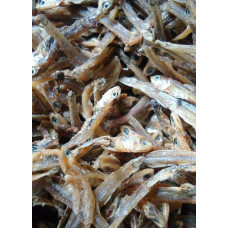Latin name
Encrasicholina oligobranchus
Other names
Encrasicholina oligobranchus
Identification
This species is characterized by the following set of characters: 16-22 pseudogill spicules (16); first gill arch with gill stamens on upper limbs 12-14 (13), lower limbs 16-18 (17), total 28-32 (30); second gill arch with gill stamens on upper limbs 10-11 (10), lower limbs 12-17 (16), total 22-27 (27); third gill arch with gill stamens on upper limbs 8-9 (9), lower limbs 10-11 (10), total 18-20 (18); fourth gill arch with gill stamens 6-8 (7) upper limbs, 8-9 (8) lower limbs, total 14-16 (19); gill stamens 3-5 (4) on posterior surface of third gill arch; spiny flaps on abdomen 3-6 (4); transverse scales 8-9 (9); open diuretic canal bony, without fleshy tubercles; head large, its length 28. 3-29.8% (average 28.9%) of SL; maxilla rather long, its length 19.0-20.7% (19.9%) of SL, its posterior tip barely reaching the anterior margin of the tarsal; mandible rather long, its length 19.1-20.5% (19. 7%) of SL; orbit is long, its diameter is 8.3-8.8% (8.6%) of SL; snout is long, its length is 4.9-5.2% (5.1%) of SL; body is elongated, its depth is 13.3-15.3% (14.5%) of SL; pelvic fin is short, its length is 8.7-9.4% (9.0%) of SL.
Features of fish fins
Dorsal spines (total): 0. Anal spines: 0. Soft anal fin rays: 15. These fish have 3 unbranched dorsal and anal fin rays. 11-14 branched pectoral rays (usually 12).
Fish colouring
These fish have a silvery gray body coloration.
Distribution
Occupies the west central Pacific Ocean: Taiwan, the Philippines, Indonesia, and Tonga.
Habitat
Marine, pelagic-neritic, tropical species. Distribution: 17°N to 4°N, 116°E to 133°E.
Size
This species reaches a length of 6.2 cm.
Behavior
They show up at school. Probably a gregarious species. Apparently rare.
Food and feeding habits
Probably feeds mainly on planktonic crustaceans (e.g. paddlefish).
Reproduction
Eggs are oval. Eggs are occasionally found in the lower reaches of mangroves.
Fishing
Not interesting for fishermen.
Relationship with a person
Mainly used as bait, but also consumed as food.
| Classification | |
| Phylum | Chordata |
| Class | Actinopterygii |
| Squad | Clupeiformes |
| Family | Engraulidae |
| Genus | Encrasicholina |
| Species | E. oligobranchus |
| Features | |
| Conservation status | Data Deficient |
| Habitat | Pelagic |
| Life span, years | No information |
| Maximum body weight, kg | No information |
| Maximum length, cm | 6,2 |
| Sailing speed, m/s | No information |
| Threat to people | Edible |
| Way of eating | Planktonophage |
Philippine anchovy
Tags: philippine anchovy

